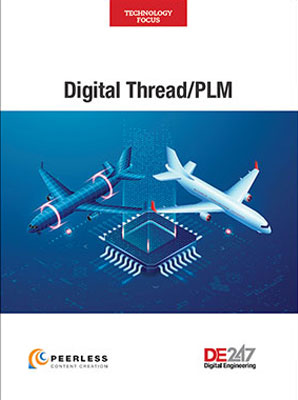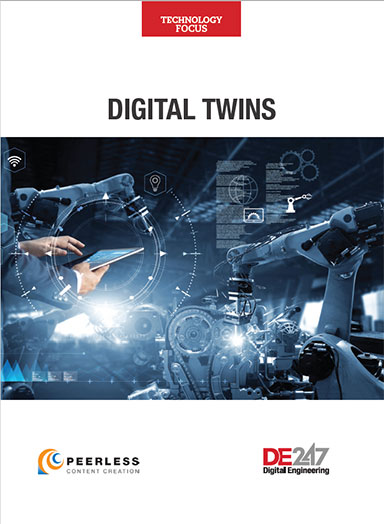Is Digital Transformation Stuck in Neutral?
Engineering has an appetite for new technologies to digitally transform, yet traditional silos and culture remain obstacles to large-scale success.

Digital twins factor heavily into Team Penske’s efforts to transform design and development. Image courtesy of Team Penske.
Latest News
July 1, 2019
Automakers are accelerating development cycles by 3D printing prototype parts and tooling in lieu of traditional manufacturing processes. In the aerospace sector, players are leveraging the Internet of Things (IoT) to collect a vast array of sensor data to help proactively flag potential part failures or to determine when an engine is due for routine service. Even slower-moving industries like shipbuilding have their sights set on 3D modeling capabilities from simulation to augmented and virtual reality (AR/VR) to shore up and modernize traditional development practices.
Although companies in nearly every major sector have embarked on some leg of the digital transformation journey, there are still countless unexplored routes and many miles to travel. The reality is that despite the drumbeat of press reports and prominent user stories, successful and holistic transformation of engineering and product development processes still remain the exception, not the rule. Newer technologies aside, even product lifecycle management (PLM), the decades-old software platform and business process approach for syncing engineering with relevant stakeholders throughout the lifecycle, has not lived up to its full transformational potential.
“If you’re a product company and you want to do digitalization, then your PLM game needs to be pretty on point, but that’s further than most people are,” says Stan Przybylinski, vice president of CIMdata. “It’s amazing how many companies adopt these core data and process management platforms with lofty goals and most remain stuck in PDM (product data management). Even while vendors add all these new capabilities, the majority of companies are just doing basic blocking and tackling.”
Persistent Silos Are a Problem
Compared to other areas of the business like marketing or sales, engineering is more likely to lag behind in the race to digitize core processes—in part because of the complexity of the technology. However, the more acute stumbling block is not with established or even newer technologies, but rather the long-seated cultural norms that promote a siloed approach to workflow and product-related data.

“Most of the time companies get stuck due to organizational stuff,” says Przybylinski. “Organizations are not necessarily structured in a way that promotes optimal collaboration. Instead, they are still operating as separate functions.”
Engineering’s inclination to guard siloed product data and reticence to share work-in-progress design materials are other big hurdles standing in the way of effective transformation.
“With PLM, we see a lot of complaining that others will see into their department or work product, and that comes from a silo mentality,” notes Jonathan Scott, chief architect at Razorleaf, a consultancy specializing in PLM and engineering-related implementations. “If you work in product definition, you are supposed to work with people in other domains. You need to be in continuous integration mode where everyone is involved in evolving the baseline. Exposing work should not be viewed in a bad way, but in a good way that lets you move ahead.”
In a similar vein, if transformation is all about changing business models (to product-as-a-service, for example) or redefining processes to bolster innovation, organizations need to extend their goals far beyond engineering. Specifically, they need to create a seamless flow of data along with integrated and automated workflows that encompass the full operational lifecycle. That’s where the concept of the digital thread comes in.
Much like in the early days of PLM, there is plenty of high-level posturing about how the digital thread will deliver untold insights and streamline processes leading to more innovative products, predictive maintenance services, even just-in-time, custom manufacturing practices. At the same time, however, there is still a lack of consensus on what the digital thread actually constitutes and far less clarity on how to effectively put the concept into play.
The digital twin, another crucial building block for digital transformation of product development and engineering, is also open to slightly different interpretations depending on the provider or the enterprise. Some vendors, like Dassault Systèmes and Siemens PLM Software, view the digital twin as a full 3D representation and systems model of a product and its behavior, while companies like PTC have a similar view, but associate a digital twin with a very specific, serial-numbered product.
At the same time, there can be glaring gaps of relevant data and loose ends in both the digital twin and the digital thread. For example, companies may have gone as far as to create a digital twin of a product, including collecting usage data while out in the field, but have not yet figured out how to create an effective closed-loop workflow that feeds that data directly back to engineering so it can leverage intelligence for future product iterations.
Similarly, while organizations have made good strides integrating mechanical and electrical CAD data, software development—a critical aspect of most modern-day products—is still often handled in a separate system as is service information. Without the totality of data and a seamless process, the utility of a digital thread is undermined.
“Companies need to focus on how the digital thread connects data used all the way through the lifecycle to generate better decisions and to get upgrades and better products out the door,” says Mark Reisig, director of marketing at Aras. “If engineering is focused on one-off projects, they might improve the customer experience, but if they’re not connecting processes throughout the end-to-end lifecycle, they are not helping the business.”
“So many folks in engineering talk in bits and bytes and that doesn’t help people to understand what they’re talking about. Executives won’t fund what they don’t understand.”
— Jonathan Scott, Razorleaf
Beneteau, a French boat manufacturer, is piloting its PLM foundation toward a seamless digital thread of data with the aim of promoting reuse, shortening development time and aiding workers in boat assembly, according to CIO Bertrand Dutilleul. The implementation of PTC’s Windchill PLM platform, to take place over the next 18 months, is broken up into three 6-month phases: The first 6 months is focused on creating accurate work instructions for existing boat designs followed by a phase where the team builds a new boat that will be put into production and pushed to the shop floor to build familiarity and confidence with workers in the new digital approach. Once the kinks are hammered out, the digital workflows will be deployed plant by plant.
“It is very important to have a reference plant—the key to success is selecting the right team for your first project,” Dutilleul says. “You need an energetic, visionary project leader to establish momentum and provide continued executive sponsorship.”
With the core PLM foundation in place, Beneteau expects to evolve its digital transformation efforts over time with new capabilities like augmented reality to better define the product through engineering collaboration, help factory workers with digital work instructions and make it easier for customers to configure their boat designs. IoT will eventually come into play for preventive maintenance and to better understand how the boats are used in the field to inform future design decisions, he explains.
“These use cases are only made possible by first building a solid foundation through PLM,” Dutilleul says.
Engineering organizations can get waylaid by focusing on projects that implement sexy new technologies like AR/VR or 3D printing without first taking on the heavier lifting to determine how to create that operational lifecycle view. “Oftentimes, organizations are buying technology with no particular plan,” Aras’ Reisig says. “They are not looking at the business horizontally and this is where they get stuck.”
Beyond integrating siloed systems, a digital transformation effort is also about standardizing and harmonizing processes so everyone is operating from the same playbook. Yet asking people to change behavior and be open to other ways of working is always an uphill change management battle, especially if there aren’t overt problems or active pain points crying out for a solution.
“The drive to harmonize processes is typically a company perspective, but engineers doing the work may not be dissatisfied enough, thus are not anxious to change what they do except in incremental ways,” explains Mark Taber, vice president of marketing and go-to-market strategy for PTC.
For established companies in well-entrenched markets, transformation and disruption is exceedingly difficult when you have to balance your existing product portfolio and product development practices with incremental improvement. “You’re thinking about how you get from here to there, not where you want to be,” Razorleaf’s Scott explains. “If you have to bring along the baggage of what you’re always done, you’ve got an extra constraint to deal with, and it’s a big one.”
Guillaume Vendroux, CEO, DELMIA, Dassault Systèmes, agrees. “The projects I see failing never fail for technology reasons. They fail because of change management. That can be avoided. The problem of transformation is likely to happen when a business is not engaged. The business needs to engage. It needs to build digitally minded processes in order to leverage the technology to get the value out of it. I see that on a constant basis.”
Best Practices for Change
To break down the silo mentality and thread the needle for seamless digital processes, organizations need to adopt systems engineering practices, including model-based systems engineering. The latter uses models as a framework to represent the shape, behavior and contextual information surrounding a product throughout the design process, across the full lifecycle and spanning all the different technical disciplines.
“Systems engineering helps us see across discipline lines by looking at the design and definition of a product while things are still fuzzy,” Razorleaf’s Scott says. “Getting everyone in the various disciplines to look up higher in the process is how we become more holistic.”
Embracing agile practices, especially as organizations roll out complex initiatives like PLM, is another important milestone, according to CIMdata’s Przybylinski. Agile practices can help remove cost and complexity barriers to PLM implementations; however, the shift creates additional challenges.
“The agile methodology allows you make errors and correct them quickly because you learn from the errors,” Vendroux says. “This is the reason why people are using agile, even though if you look on paper, it is significantly more complicated to manage and so therefore costs a bit more. But, it’s so much more powerful at the end of the day.”
Creating a product-centric delivery view as opposed to the traditional functional view also encourages cross-discipline collaboration. This extends to creating multidisciplinary teams internal to engineering but that also cross over to include non-engineering roles in manufacturing or supply chain, for examples.
“You need to create teams with multiple skills that have one common vision for product features,” notes Vinod Subramanyam, head of the digital infrastructure practice at Brillio, which specializes in helping companies with digital transformation.
Along with new management and team collaboration structures, enlisting a key executive as a sponsor is critical to getting the necessary buy-in. To do so, engineering management needs to be able to effectively communicate the business case for digitizing processes and investing in new platforms.
“So many folks in engineering talk in bits and bytes and that doesn’t help people to understand what they’re talking about,” Scott says. “Executives won’t fund what they don’t understand.”
At Team Penske, an American professional motorsports organization, the push for digital transformation came from both top down and bottom up. The race team, which has to drive performance year-over-year, but also continuously throughout racing season, adopted an entirely new engineering platform in 2018 based on Siemens PLM Software’s NX, Teamcenter PLM and simulation platforms. After a full year of planning, including migrating legacy engineering data, creating system architecture and end-user training, the race team went into overdrive with the new platform, which includes using digital twin methodology such as virtual models and simulation capabilities to quickly iterate and bring new prototypes to life before building any physical products.
“End users have become aware of what’s possible with digital models, making their daily tasks more straightforward and allowing them to be more effective,” notes Drew Kessler, design engineering manager for Team Penske. “Top management has been pushing for performance increases at a faster rate, which is also enabled by digital methods.”
Team Penske plans to integrate Teamcenter Manufacturing with managing build processes to shrink the time between design and manufacturing while refining digital twins. “Having a functional digital twin and using virtual/digital development methods allows us to develop at a rate faster than our competition,” Kessler says. “Time to market is critical in motorsports—there is a race on the track every weekend, but between the weekends, there is a race to develop and manufacture new parts.”
In the end, however, companies need to remember that digital transformation is a marathon, not a sprint.
“You’re talking about people modifying the way they’ve done things before,” says Del Costy, senior vice president and managing director of Siemens PLM Software’s Americas’ digital industry software division. “Companies that set a vision and see it through end-to-end get great results identifying new business opportunities and driving profitability—and that’s the holy grail of transformation.”
More CIMdata Coverage
More Dassault Systemes Coverage

More PTC Coverage
More Razorleaf Coverage
More Siemens Digital Industries Software Coverage
Subscribe to our FREE magazine, FREE email newsletters or both!
Latest News
About the Author
Beth Stackpole is a contributing editor to Digital Engineering. Send e-mail about this article to [email protected].
Follow DE







